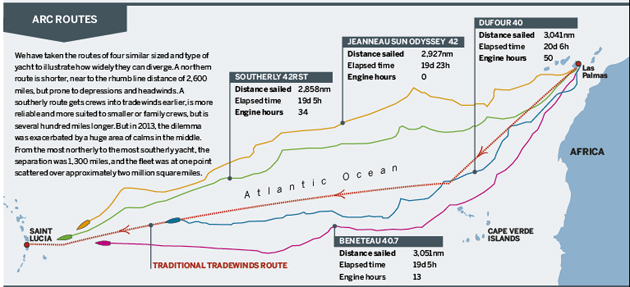Yachts are getting bigger, though production designs predominate for crossing the Atlantic in the ARC. Our survey reveals all
We first started our ARC survey 14 years ago and have been collecting data annually on the types of gear yachts carry and how skippers rate it. It’s the largest yachting equipment survey in the world, sampling the experiences of over 250 skippers taking part each year sailing over one million miles between them on the transatlantic rally from Gran Canaria to Saint Lucia.
This year we decided to look in depth at the boats, skippers and crews taking part: boat sizes; purchase costs; crew numbers and ages; crossing times and routes among them.
Transatlantic yachts – a profile
The ARC has evolved throughout its 28-year history: the rally has got bigger and so, on average, have the yachts taking part. These changes reflect general trends in sailing and the marine industry: production designs still predominate, but growing affluence has steadily pushed up the size ranges.
The average boat size last year was 48ft 4in. Smaller boats now rank as those under 40ft and they are very much in the minority but, most tellingly, the greatest concentration of yachts it is in the 40-50ft band, seemingly now considered the optimum size for long-term or long-distance cruising by a crew of family and friends.
Another point of interest is that the ARC fleet is made up of comparatively new yachts and modern designs. The median age of boat was seven years old and many skippers had chosen and bought their current yachts specifically with an Atlantic circuit in mind.
A significant proportion of ARC boats were new launches. In spite of the recession, some 25 per cent of rally yachts in the last couple of years were launched within the previous 12 months, most of them over 45ft. Shakedown problems, it must be said, do come with the territory.
In the most populous 40-50ft band, there was a large variation in price paid for yachts. A majority had paid between €120,000-250,000, but half that number payed €250,000-500,000.
The skippers and crews
What has not changed over the years is the profile of a typical bluewater cruising skipper. The average age of skippers was 55 and, in our experience, most are early-retired, cashed out of a business or managing oversight of an ongoing business, with day-to-day management devolved to someone else to allow some extended time away.
This profile hasn’t changed much and probably isn’t likely to. To allow for longer term sailing, time, opportunity and money have to merge, and the mid- to late fifties seems to be the easiest stage.
A difficulty can be where to find crew who also have the time for long cruise and its preparation. Last year there were 1,407 crew, mostly family and friends. The average crew number was five people: enough to establish a strong watch system but not too large to cramp accommodation.
Perhaps because of the difficultly of finding crew with the same free time and mindset, many couples prefer to sail double-handed. Last year there were 27 two-handed crews – just over ten per cent of the fleet.
If average boat LOA is a guide, the ideal size for double-handlers is around 41ft. At this size boat systems are manageable by two, and provided there is redundancy in essential systems such as the autopilot or self-steering and power generation, these couples usually do well.
The key thing seems to be working out how to cope in case of a major breakage or gear failure.
Atlantic routes
We have taken the routes of four similar size and type of yacht to illustrate how widely they can diverge. A northern route is shorter, near to the rhumb line distance of 2,600 miles, but prone to depressions and headwinds. A southerly route gets crews into tradewinds earlier, is more reliable and more suited to smaller or family crews, but is several hundred miles longer.
But in 2013, the dilemma was exacerbated by a huge area of calms in the middle. From the most northerly to the most southerly yacht, the separation was 1,300 miles, and the fleet was at one point scattered over approximately two million square miles.
See also our meteorologist Chris Tibbs’s advice on the best route for an Atlantic crossing
Equipment carried by the ARC yachts









